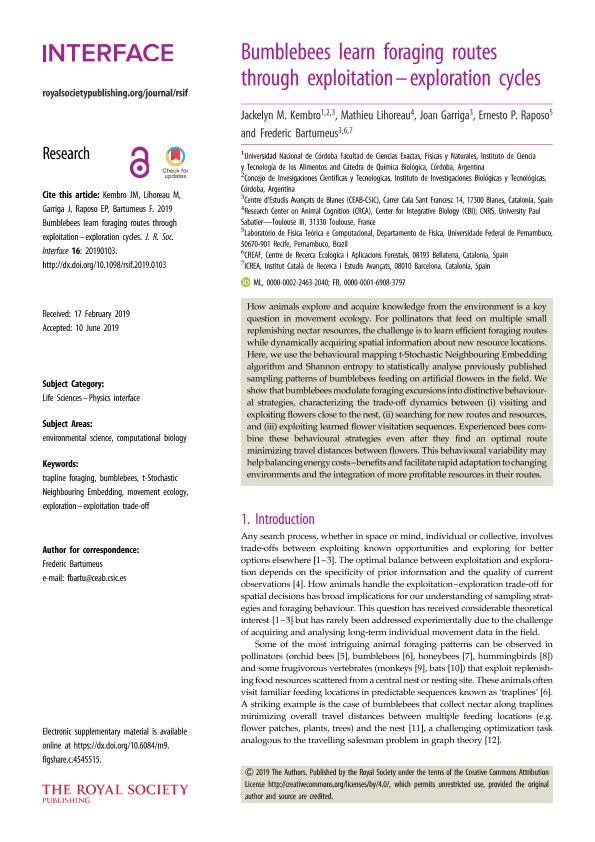Mostrar el registro sencillo del ítem
dc.contributor.author
Kembro, Jackelyn Melissa

dc.contributor.author
Lihoreau, Mathieu
dc.contributor.author
Garriga, Joan
dc.contributor.author
Raposo, Ernesto P.
dc.contributor.author
Bartumeus, Frederic
dc.date.available
2020-03-18T16:18:48Z
dc.date.issued
2019-07-10
dc.identifier.citation
Kembro, Jackelyn Melissa; Lihoreau, Mathieu; Garriga, Joan; Raposo, Ernesto P.; Bartumeus, Frederic; Bumblebees learn foraging routes through exploitation-exploration cycles; The Royal Society; Journal of the Royal Society Interface; 16; 156; 10-7-2019; 1-12
dc.identifier.issn
1742-5689
dc.identifier.uri
http://hdl.handle.net/11336/100043
dc.description.abstract
How animals explore and acquire knowledge from the environment is a key question in movement ecology. For pollinators that feed on multiple small replenishing nectar resources, the challenge is to learn efficient foraging routes while dynamically acquiring spatial information about new resource locations. Here, we use the behavioural mapping t-Stochastic Neighbouring Embedding algorithm and Shannon entropy to statistically analyse previously published sampling patterns of bumblebees feeding on artificial flowers in the field. We showthat bumblebeesmodulate foraging excursions into distinctive behavioural strategies, characterizing the trade-off dynamics between (i) visiting and exploiting flowers close to the nest, (ii) searching for new routes and resources, and (iii) exploiting learned flower visitation sequences. Experienced bees combine these behavioural strategies even after they find an optimal route minimizing travel distances between flowers. This behavioural variability may help balancing energycosts-benefits and facilitate rapidadaptationto changing environments and the integration of more profitable resources in their routes.
dc.format
application/pdf
dc.language.iso
eng
dc.publisher
The Royal Society

dc.rights
info:eu-repo/semantics/openAccess
dc.rights.uri
https://creativecommons.org/licenses/by-nc-sa/2.5/ar/
dc.subject
BUMBLEBEES
dc.subject
EXPLORATION-EXPLOITATION TRADE-OFF
dc.subject
MOVEMENT ECOLOGY
dc.subject
T-STOCHASTIC NEIGHBOURING EMBEDDING
dc.subject
TRAPLINE FORAGING
dc.subject.classification
Biología

dc.subject.classification
Ciencias Biológicas

dc.subject.classification
CIENCIAS NATURALES Y EXACTAS

dc.title
Bumblebees learn foraging routes through exploitation-exploration cycles
dc.type
info:eu-repo/semantics/article
dc.type
info:ar-repo/semantics/artículo
dc.type
info:eu-repo/semantics/publishedVersion
dc.date.updated
2020-01-13T14:40:09Z
dc.identifier.eissn
1742-5662
dc.journal.volume
16
dc.journal.number
156
dc.journal.pagination
1-12
dc.journal.pais
Reino Unido

dc.journal.ciudad
Londres
dc.description.fil
Fil: Kembro, Jackelyn Melissa. Consejo Nacional de Investigaciones Científicas y Técnicas. Centro Científico Tecnológico Conicet - Córdoba. Instituto de Investigaciones Biológicas y Tecnológicas. Universidad Nacional de Córdoba. Facultad de Ciencias Exactas, Físicas y Naturales. Instituto de Investigaciones Biológicas y Tecnológicas; Argentina
dc.description.fil
Fil: Lihoreau, Mathieu. Université Paul Sabatier; Francia
dc.description.fil
Fil: Garriga, Joan. Centro de Estudios Avanzados de Blanes; España
dc.description.fil
Fil: Raposo, Ernesto P.. Universidade Federal de Pernambuco; Brasil
dc.description.fil
Fil: Bartumeus, Frederic. Centro de Estudios Avanzados de Blanes; España. Consejo Superior de Investigaciones Científicas. Centre de Recerca Ecológica I Aplicacions Forestals; España. Institució Catalana de Recerca i Estudis Avancats; España
dc.journal.title
Journal of the Royal Society Interface

dc.relation.alternativeid
info:eu-repo/semantics/altIdentifier/url/https://royalsocietypublishing.org/doi/10.1098/rsif.2019.010
dc.relation.alternativeid
info:eu-repo/semantics/altIdentifier/doi/http://dx.doi.org/10.1098/rsif.2019.0103
Archivos asociados
